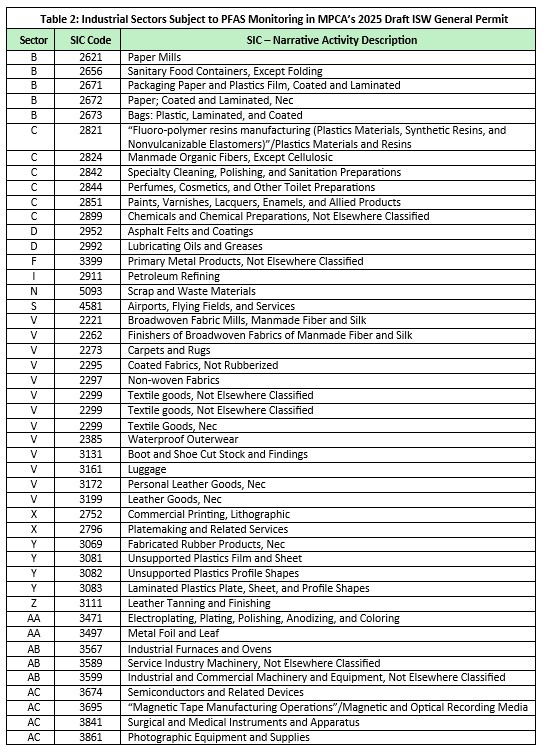What Happened?
On January 27, 2025, the Minnesota Pollution Control Agency (MPCA) issued a draft National Pollutant Discharge Elimination System (NPDES)/State Disposal System (SDS) general permit to control pollution generated from rain and snow melt runoff (i.e., stormwater) associated with industrial activities discharging into waters of the State of Minnesota (ISW General Permit or Permit). Once finalized, the Permit will replace the current ISW General Permit, which expires on March 31, 2025.
Why Is It Significant?
The draft Permit is notable because it would require, for the first time, that permittees monitor their stormwater runoff for per-and polyfluoroalkyl substances (PFAS) compounds. These monitoring requirements would apply not only to permittees but also to entities seeking a no-exposure permitting exclusion, which would represent the first time no-exposure applicants have been required to conduct stormwater sampling. The draft permit’s PFAS requirements continue state and federal efforts to limit pollution from PFAS (often referred to as “forever chemicals”).
Who Is Affected?
Minnesota regulates stormwater discharges from entities in 29 industrial sectors, based on Primary Standard Industrial Classification (SIC) code. Thousands of Minnesota businesses in these sectors must seek coverage under the ISW General Permit or apply for a no-exposure exclusion. The draft Permit’s PFAS provisions apply only to a subset of the 29 industrial sectors, as listed in Table 2, below.
What Can You Do?
Comment on the draft Permit. The MPCA is accepting public comments on the draft Permit until 11:59 p.m. on February 26, 2025. Members of the public can also request a contested case hearing on the draft Permit under Minn. R. 7000.1900, subp. 1.
Make preparations to comply with the new Permit once it is finalized, including not only the new PFAS provisions but also numerous other requirements that are new from the 2020 Permit. Some of these new requirements are summarized below.
How Can Fredrikson Help?
Fredrikson’s environmental team has deep experience with all aspects of water law in Minnesota, including stormwater permitting under the NPDES permitting program. We can assist with preparing comments on the draft Permit, complying with the Permit once it is finalized, or assisting with any other water-related legal issues. For more information, please visit our website.
Background on Minnesota’s Industrial Stormwater Permitting Program
The federal Clean Water Act (CWA) requires an NPDES permit for discharges of stormwater associated with industrial activity for any primary SIC code and/or narrative activities and co-located industrial activities as defined in 40 CFR § 122.26 (b)(14)(i- ix and xi). The activities covered by the regulation break down into 29 industrial sectors, based on Primary Standard Industrial Classification (SIC) code. Minnesota entities within these 29 industrial sectors must either obtain an NPDES permit from MPCA (which implements the NPDES permitting program in Minnesota) or apply for a no-exposure exclusion. The vast majority of the several thousand Minnesota entities that require an industrial stormwater permit seek coverage under MPCA’s ISW General Permit.
In most cases, the ISW General Permit does not impose numeric effluent limits for regulated pollutants, as a traditional individual NPDES permit does. Rather, the Permit requires permittees to implement best management practices (BMPs) — outlined in a mandatory Stormwater Pollution Prevention Plan, or “SWPPP” — to reduce the exposure of industrial materials and activities to precipitation. To measure the success of the BMPs, permittees must sample runoff from their sites and compare them against benchmark values for specified pollutants, which are set forth in the Permit. If average pollutant levels from four consecutive quarterly samples are below the benchmark values, the permittee can stop monitoring for the balance of the Permit’s term.
As an alternative to obtaining coverage under the Permit, the Owner/Operator of a facility can apply to MPCA for a no-exposure exclusion, certifying that all industrial materials and industrial activities at the facility are either indoors or under a storm-resistant shelter, such that they are not exposed to rain, snow, snowmelt and runoff and thus will not pollute stormwater. Upon submittal of the no-exposure application, the applicant is excluded from the requirement to obtain permit coverage for industrial stormwater. A no-exposure exclusion is valid as long as the requirements of no-exposure are met, but no longer than the term of the then-current ISW General Permit.
New Provisions in the Draft ISW General Permit
The draft Permit includes several significant changes from the current version, including, for the first time, requirements to sample for PFAS compounds — even for entities seeking a no-exposure exclusion.
New Provisions Related to PFAS
PFAS Benchmark Monitoring, Reduction Plans
The draft Permit requires permittees falling within approximately half of the regulated industrial sectors (see the list of sectors in Table 2, below) to monitor for PFAS by collecting stormwater samples for at least four consecutive calendar quarters following the permittee’s date of coverage. Permittees must take the PFAS samples at each “area of concern” (AOC) at their facility. An AOC is defined in the draft Permit as “the area(s) of the facility where the Permittee, through an industrial activity, makes, uses, stores or processes PFAS containing materials and/or where vents or exhausts are located on buildings that make, use, store or process PFAS, or areas of the facility where PFAS would become exposed, if potentially present at the facility.” The sampling must be conducted in accordance with the U.S. EPA’s Method 1633. If the average values of the four quarterly PFAS samples are above the draft Permit’s PFAS monitoring values, the permittee must prepare and implement a PFAS Source and Exposure Reduction Plan.
For facilities that are within one mile of a Class 1 Water (protected for domestic use) or a Drinking Water Supply Management Area (DWSMA, as defined in Minn. R. 4720.5100, subp. 13), MPCA has established PFAS monitoring values for five PFAS compounds, which are based upon EPA’s 2024 PFAS national drinking water standards. For all other facilities, MPCA has established PFAS monitoring values only for PFOS and PFOA, based upon the “conservative thresholds” MPCA used in its 2022 PFAS Monitoring Plan. The PFAS monitoring values are set forth Table 1.
PFAS Sampling Requirements for No-Exposure Exclusion Applicants
The draft Permit imposes, for the first time, monitoring requirements on entities applying for the No-Exposure exclusion. Specifically, entities in the industrial categories listed in Table 2, below, must provide verification that they have sampled their stormwater for PFAS using Method 1633 at least four times, 72-hours apart, before applying for a no-exposure exclusion. In order to qualify for the no-exposure exclusion, the averaged results of the four samples must be below the PFAS monitoring values listed in Table 1.
New Provisions in the 2025 Draft ISW General Permit Not Related to PFAS
Other notable new provisions in the draft 2025 ISW General Permit include but are not limited to the following:
- More Frequent SWPPP Updates: The draft Permit includes new provisions requiring permittees to amend their SWPPP within 30 days upon the occurrence of certain events, including (a) a change in design or operation of the facility that affects stormwater; (b) discovery that a monitoring location is within 1 mile of a newly listed impaired water; (c) identification of deficiencies in the SWPPP or BMPs; (d) there is an unauthorized discharge from the facility; and (e) a change in personnel responsible for managing stormwater.
- Salt Storage and Use: Permittees must indicate in their SWPPP how they will minimize runoff from the use of salt or other de-icing materials used on site.
- Maintenance Plans for Basins: Permittees with stormwater sedimentation and infiltration basins must include maintenance plans for the basins in their SWPPP.
- More Specificity on Benchmark Monitoring Locations: The draft Permit specifies that Permittees must select benchmark monitoring locations that: (a) are located after the final down-gradient BMP but prior to discharging from the permittee’s operational control; and (b) minimize or eliminate sampling of stormwater from off-site.
For more information, please see MPCA’s draft Permit, fact sheet and related materials on MPCA’s website.




